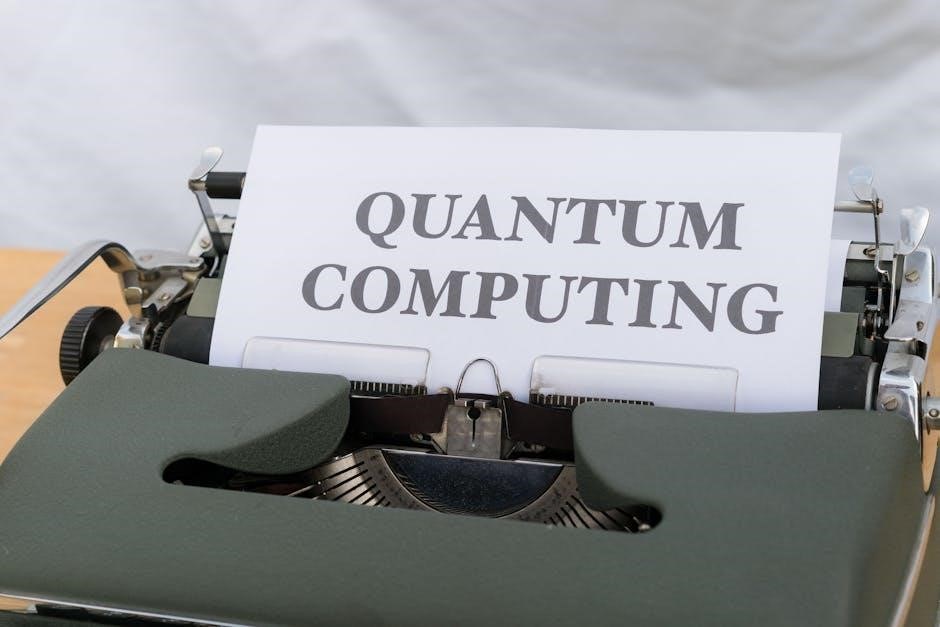sakurai quantum pdf
Modern Quantum Mechanics by J.J. Sakurai is a renowned graduate-level textbook that presents quantum mechanics with clarity and depth, making it a cornerstone in physics education.
Overview of the Book
Modern Quantum Mechanics by J.J. Sakurai is a comprehensive graduate-level textbook that systematically explores the principles of quantum mechanics. Known for its clear structure and rigorous mathematical approach, the book covers foundational concepts, advanced techniques, and modern experiments. It emphasizes clarity and depth, making complex ideas accessible to students and researchers. The text is widely regarded for its logical flow and engaging presentation, solidifying its place as a cornerstone in quantum mechanics education. Its popularity has led to multiple editions, each refining and expanding the content.
Author Background and Contributions
J.J. Sakurai was a distinguished theoretical physicist whose work significantly influenced quantum mechanics education. Born in 1933, Sakurai was known for his exceptional teaching skills and ability to simplify complex concepts. His contributions to particle physics and quantum field theory are notable, and his textbook, Modern Quantum Mechanics, remains a standard reference. After his untimely death in 1982, the book was revised by Jim Napolitano, ensuring Sakurai’s legacy continues to inspire future generations of physicists through his clear and engaging approach to the subject.
Significance in Quantum Mechanics Education
Modern Quantum Mechanics holds a pivotal role in graduate-level education, offering a comprehensive and accessible exploration of quantum principles. Its structured approach bridges theoretical foundations with practical applications, making it indispensable for students and researchers alike. The book’s clarity and depth have solidified its reputation as a primary resource, shaping understanding and fostering advancements in the field. Its availability in PDF format ensures widespread access, further cementing its influence in modern quantum mechanics studies and related disciplines.
Key Concepts Covered in the Book
Modern Quantum Mechanics covers foundational principles, advanced mathematical techniques, and modern topics like neutron interferometry and Bell’s inequality, ensuring a comprehensive understanding of quantum theory.
Foundations of Quantum Mechanics
Modern Quantum Mechanics begins with the core principles of quantum theory, including wave-particle duality, uncertainty principle, and Schrödinger’s equation. It explores the mathematical framework, such as Hilbert spaces and operators, providing a rigorous foundation. The book introduces key concepts like wavefunctions, probability amplitudes, and the role of observables, ensuring a solid understanding of quantum mechanics’ theoretical underpinnings. These foundational topics are presented with clarity and depth, making them accessible to graduate students and researchers alike.
Advanced Mathematical Techniques
Modern Quantum Mechanics delves into advanced mathematical methods essential for understanding quantum systems. Techniques such as operator algebra, Fourier transforms, and group theory are thoroughly explored. The book emphasizes the use of Hilbert spaces, eigenvalue problems, and perturbation theory, providing a robust framework for analyzing complex quantum phenomena. These mathematical tools are applied to solve real-world problems, bridging theory and practical applications in physics. The text’s clear presentation makes these advanced concepts accessible to graduate students and researchers.
Neutron Interferometer Experiments
Modern Quantum Mechanics discusses neutron interferometer experiments, which demonstrate quantum phenomena like wave-particle duality and coherence. These experiments, highlighted in the second edition, provide empirical validation of quantum theories. By analyzing neutron beam interference, researchers can observe quantum effects in action, offering insights into fundamental physics. The book explains how these experiments confirm theoretical predictions, making them a cornerstone in quantum mechanics education and research.
Bell’s Inequality and Its Implications
Bell’s inequality, introduced by physicist John Bell, challenges the principles of local hidden variable theories. Modern Quantum Mechanics explores how quantum mechanics violates Bell’s inequality, supporting the non-local nature of quantum systems. This has profound implications for understanding quantum entanglement and the foundations of reality. The book provides a detailed analysis of Bell’s theorem and its experimental verification, making it a crucial topic in quantum mechanics education and research.
Editions and Revisions
The book is available in PDF format across its three editions, with the second and third editions incorporating updates and advanced topics respectively, enhancing accessibility for students and researchers.
First Edition: Core Ideas and Structure
The first edition of Modern Quantum Mechanics by J.J. Sakurai laid the foundation with its clear presentation of core concepts. It introduced key topics like wave functions and operators, establishing a structured approach that balanced theory and applications. The edition emphasized mathematical rigor while maintaining accessibility, making it a preferred resource for graduate students. Its organized layout and comprehensive coverage set the standard for future revisions, ensuring its lasting impact in quantum mechanics education.
Second Edition: Updates and Enhancements
The second edition of Modern Quantum Mechanics by J.J. Sakurai and Jim Napolitano builds on the first, incorporating advancements in quantum theory. It introduces new topics such as neutron interferometer experiments and Bells inequality, enhancing the books relevance to modern research. The edition refines explanations, improves problem sets, and expands applications, ensuring it remains a leading graduate textbook. These updates maintain the books clarity and depth, solidifying its place as a essential resource for quantum mechanics studies.
Third Edition: New Topics and Applications
The third edition of Modern Quantum Mechanics expands its scope with new chapters on advanced mathematical techniques and experimental implications. It delves into cutting-edge topics like quantum field theory and modern experimental methods, providing a comprehensive understanding. This edition bridges theory and practice, offering insights into real-world applications. Enhanced clarity and updated references make it invaluable for researchers and students, ensuring its continued relevance in the evolving field of quantum mechanics.
PDF Availability and Access
The PDF of Modern Quantum Mechanics is widely available online, with options to download from platforms like Scribd or access via subscription services like Perlego.
Downloading the PDF from Reliable Sources
The PDF of Modern Quantum Mechanics can be downloaded from reliable sources like Scribd, Perlego, or official academic platforms. Ensure legality by accessing through verified publishers or educational services. These sources provide clear, well-organized versions of the textbook, ideal for graduate studies. Additionally, some platforms offer related materials, such as solution manuals and study notes, enhancing the learning experience for students engaged with Sakurai’s work.
Legal and Ethical Considerations
Downloading Modern Quantum Mechanics as a PDF requires adherence to copyright laws. Accessing it through official publishers or academic platforms ensures legality. Ethical usage involves respecting intellectual property rights by purchasing or borrowing through legitimate channels. Unauthorized downloads from unverified sources may violate copyright and undermine authors’ contributions. Always opt for legal methods to support authors and publishers while benefiting from this essential textbook in quantum mechanics education.
Online Platforms for Access
Accessing Modern Quantum Mechanics online is convenient through platforms like Scribd and academic databases. Perlego offers a subscription-based service for e-books, including this textbook; Official publishers and university libraries provide legal access to PDF versions, ensuring compliance with copyright laws. Additionally, platforms like ResearchGate and Academia.edu may host shared resources, though verification is essential. These platforms facilitate easy access for students and researchers while maintaining ethical standards and supporting intellectual property rights.

Supplementary Resources
Supplementary resources for Modern Quantum Mechanics include solutions manuals and exercise problems, enhancing understanding and application of the textbook’s concepts effectively for students.
Solutions Manual and Exercise Problems
The solutions manual for Modern Quantum Mechanics provides detailed answers to exercise problems, aiding students in understanding complex concepts. It is available as a PDF download, often archived alongside the main textbook. This resource is invaluable for self-study and exam preparation, offering insights into solving quantum mechanics problems methodically.
Additional Notes and Study Materials
Supplementary notes and study materials for Modern Quantum Mechanics are widely available online, offering deeper insights into the textbook’s content; These resources include lecture notes from professors, such as Prof. Yiheng Lin’s quantum mechanics course, and archived solutions to exercise problems. Additionally, materials like the Weber-Hermite differential equation and interpretations of quantum mechanics provide further exploration of key topics. These resources are invaluable for students seeking to enhance their understanding of the subject.
Related Textbooks and Comparisons
Modern Quantum Mechanics is often compared to other influential textbooks in the field, such as those by Schwabl, Moreira, and Nguyen. While these texts cover similar topics, Sakurai’s work is praised for its clear and engaging presentation. For instance, Feynman’s volume on quantum mechanics is also highly regarded but is often considered more specialized. Sakurai’s book, however, strikes a balance between depth and accessibility, making it a preferred choice for many graduate students and researchers in physics.

Reception and Reviews
Modern Quantum Mechanics is widely regarded as a classic graduate textbook, praised for its clear presentation and comprehensive coverage. It is often compared to other influential texts, such as those by Feynman, but remains a preferred choice for its accessibility and depth.
Academic Community Feedback
The academic community has praised Modern Quantum Mechanics for its rigorous yet accessible approach. Many professors have adopted it as a primary textbook for graduate courses, highlighting its ability to balance theoretical depth with practical applications. Researchers also appreciate its comprehensive coverage of advanced topics, such as neutron interferometry and Bell’s inequality, making it a valuable resource for both students and professionals in quantum mechanics.
Student Perspectives and Reviews
Students often describe Modern Quantum Mechanics as a challenging yet comprehensive resource. Many appreciate its clear explanations and logical structure, which ease the learning process despite the subject’s complexity. Some find the advanced mathematical techniques and experimental discussions particularly insightful. While it is considered demanding, students agree that the book is rewarding for those committed to mastering quantum mechanics. The availability of a solutions manual and supplementary materials further enhances its value for self-study and academic success.

Comparisons with Other Textbooks
Modern Quantum Mechanics by Sakurai is often compared to textbooks like Feynman’s Lectures on Physics and Schwabl’s Quantum Mechanics. While Feynman’s work is more conceptual, Sakurai’s book is praised for its rigorous mathematical approach and in-depth explanations. Compared to other texts, Sakurai’s clarity and logical structure make it a favorite among graduate students. Its balance of theory and practical applications sets it apart, offering a comprehensive understanding of quantum mechanics that is both challenging and rewarding.
Applications and Real-World Relevance
Modern Quantum Mechanics bridges theory and practice, offering insights into real-world applications like neutron interferometry and quantum field theory, making it invaluable for researchers and experimental physicists.
Practical Applications in Physics
Modern Quantum Mechanics explores real-world applications, bridging theory and practice. Topics like neutron interferometry and quantum field theory highlight experimental relevance. The book’s clear exposition aids in understanding quantum computing, particle physics, and advanced research. It provides foundational tools for physicists tackling complex phenomena, making it indispensable for both research and education. Sakurai’s work continues to inspire practical advancements in quantum technologies and experimental physics, ensuring its lasting impact on the field.
Interdisciplinary Connections
Modern Quantum Mechanics by J.J. Sakurai bridges multiple fields, linking quantum principles to chemistry, materials science, and engineering. Its discussions on quantum field theory and particle interactions resonate with researchers in condensed matter physics and cosmology. The textbook’s emphasis on mathematical rigor also appeals to mathematicians and computer scientists, fostering interdisciplinary collaboration. Sakurai’s work thus serves as a versatile resource, driving innovation across diverse scientific domains and encouraging a holistic understanding of quantum phenomena.
Research and Experimental Implications
Modern Quantum Mechanics by J.J. Sakurai provides a robust foundation for experimental quantum physics, particularly through its detailed discussion of neutron interferometer experiments. These discussions highlight the intersection of theoretical concepts and practical verification, enabling researchers to design experiments that test quantum mechanics’ fundamental principles. The book’s exploration of Bell’s inequality further underscores its relevance to modern quantum research, inspiring investigations into quantum entanglement and non-locality. Sakurai’s work thus serves as a catalyst for advancing experimental techniques in quantum physics.

Teaching and Learning Strategies
Modern Quantum Mechanics by J.J. Sakurai employs a clear, structured approach, making complex concepts accessible. Its organized presentation aids students in understanding and applying quantum principles effectively.
Course Structures Using the Book
Universities worldwide structure quantum mechanics courses around Modern Quantum Mechanics, leveraging its clear progression from foundational concepts to advanced topics. The book’s logical organization allows instructors to design curricula that build student understanding progressively. Each chapter aligns with key topics, enabling focused lectures and homework assignments. Supplementary materials, such as solution manuals, further support teaching and learning. Its versatility accommodates both introductory and advanced courses, making it a cornerstone for graduate-level education in physics globally. The structured approach enhances comprehension of complex quantum principles effectively.
Pedagogical Approaches
Modern Quantum Mechanics employs a pedagogical approach that balances rigor with accessibility, making complex concepts intuitive. The book emphasizes clear explanations, logical flow, and practical examples to foster deep understanding. It integrates advanced mathematical techniques with physical intuition, encouraging students to engage with the material actively. The structured presentation of problems and exercises enhances problem-solving skills, while the focus on real-world applications motivates learners. This approach has made the book a preferred resource for both students and instructors in quantum mechanics education.
Engaging with Complex Topics
Modern Quantum Mechanics excels at making intricate concepts approachable. The book uses analogies, visual aids, and step-by-step derivations to simplify topics like neutron interferometry and Bell’s inequality. By breaking down complex ideas into manageable parts, it ensures that students can grasp even the most challenging material. The inclusion of real-world experiments and theoretical implications further enhances engagement, making abstract concepts relatable and interesting for learners at all levels.

Impact on Quantum Mechanics
Modern Quantum Mechanics has profoundly shaped the field, offering a clear, organized approach to complex theories. Its influence on education and research remains unparalleled, advancing understanding and inspiring new generations of physicists.
Contributions to the Field
J.J. Sakurai’s Modern Quantum Mechanics has made significant contributions to the field by providing a comprehensive and accessible framework for understanding quantum principles. The textbook’s clear exposition and rigorous mathematical approach have influenced both educational curricula and research methodologies. It has become a standard reference, bridging gaps between theory and application, and fostering deeper insights into quantum phenomena. Sakurai’s work continues to inspire advancements in theoretical and experimental physics globally.
Influence on Modern Research
Modern Quantum Mechanics has profoundly influenced modern research, offering a robust foundation for exploring quantum phenomena. Its detailed explanations and advanced techniques, such as neutron interferometry, have enabled researchers to tackle complex experimental and theoretical challenges. The textbook’s emphasis on clarity and rigor has made it an indispensable resource for scientists investigating quantum systems, from foundational studies to cutting-edge applications in quantum computing and particle physics.
Legacy of J.J. Sakurai
J.J. Sakurai’s legacy endures as a pivotal figure in quantum mechanics education. His textbook, Modern Quantum Mechanics, remains a cornerstone of graduate studies, celebrated for its lucid presentation and comprehensive coverage. Sakurai’s contributions have shaped generations of physicists, providing a bridge between theory and experimentation. His work continues to inspire research and teaching, ensuring his impact on the field of quantum mechanics is timeless and profound.

Accessibility and Future Availability
The textbook is widely available in PDF format, accessible via online platforms and subscription services, ensuring continued availability through digitization and regular updates.
Ensuring Continued Access
Efforts to ensure continued access to Modern Quantum Mechanics include digitization initiatives and subscription-based services like Perlego, which offer the book in PDF or ePub formats. Publishers are committed to maintaining its availability through regular updates and digital archiving. Additionally, online platforms and educational repositories provide downloadable versions, making the text accessible to a global audience. These measures ensure that Sakurai’s work remains a vital resource for future generations of physicists and researchers.
Digitization Efforts
Digitalization Efforts
Digitalization of Modern Quantum Mechanics has made the textbook accessible in PDF and ePub formats through platforms like Perlego and Scribd. These efforts ensure the book’s longevity and reach, allowing students and researchers to access it easily. Regular updates and archiving by publishers further enhance its availability, making it a sustainable resource for quantum mechanics studies. This digital transformation supports a broader audience, maintaining the book’s relevance in modern education and research.
Subscription Services and Updates
Subscription platforms like Perlego offer access to Modern Quantum Mechanics in digital formats, ensuring users receive the latest updates and revisions. These services provide seamless access to the third edition, featuring enhanced content and corrections. Regular updates maintain the book’s relevance, incorporating feedback from academia. This model supports continuous learning and research, making it a valuable resource for both students and professionals in quantum mechanics.